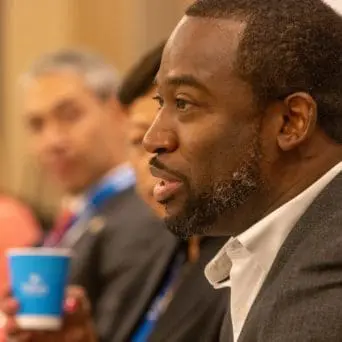Providing access to high-quality pre-K is a proven investment in children’s health and well-being, laying the foundation for better outcomes throughout their lives. But without access to these programs, children miss out on this critical opportunity to build healthier futures. CityHealth, in partnership with the National Institute for Early Education Research (NIEER), works with cities to provide all families with access to high-quality pre-K so that more children have the opportunity to succeed as they begin their educational journeys.
Going for CityHealth Gold
America’s largest cities have an opportunity to earn a CityHealth policy medal for High-Quality, Accessible Pre-K. In 2024, pre-K was the most adopted policy solution in the CityHealth policy assessment, with 73 of 75 cities earning a gold (27), silver (10), or bronze (36) medal.
To qualify for a CityHealth medal, cities must meet two of three criteria:
- Access: The city has a policy to ensure at least 30% of 4-year-olds attend a local- or state-funded pre-K program.
- Equity: The city collects demographic data that allows local leaders and residents to see who in their community is receiving services.
- Local Funding: The city includes a local funding component in its pre-K program.
To earn a silver or gold medal, cities must also meet at least eight (for silver) or nine (for gold) of 10 NIEER quality standards benchmarks, which research suggests are minimum elements of highly effective preschool programs.
Why the 30% Access Benchmark?
In 2017, CityHealth established the 30% threshold as the minimum enrollment expectation to indicate that a city is providing access to high-quality pre-K programs based on the national average of children enrolled in state-funded pre-K. Over the past decade, states have been enrolling approximately one-third of 4-year-olds nationwide in state-funded programs (except during the COVID-19 years). Yet enrollment in state-funded programs varies across the U.S. Some states and a few cities, such as Washington, D.C., offer access to all 4-year-olds, while others serve just a small proportion. Despite the overall success of CityHealth’s High-Quality, Accessible Pre-K policy solution, only 59 cities (79%) met the 30% threshold by the 2023-2024 school year.

Percentage of Children (3- and 4-Year-Olds) Enrolled in State-Funded Pre-K (2002-2023) (NIEER, 2024).
In contrast to the 30% threshold, universal pre-K (UPK) assumes that every child, typically four years old, has access to a pre-K program — though the term is defined differently by national, state, and local leaders. Within this definition, there is no single or “correct” way to define or implement providing access to early learning for all of a city’s 4-year-olds.
What Cities Can Do
Expand Access through Multiple Settings
One approach employed by pre-K systems to expand access is to leverage multiple educational settings to serve more pre-K children. According to the Alliance for Early Success, “[UPK] ensures any family who wants to enroll their preschool-aged child in a publicly-funded, pre-kindergarten care and education program has the opportunity to make that choice.”
For example, the state of California defines UPK as including the California State Preschool Program, school district-operated Transitional Kindergarten (TK), Head Start, district and local community-based preschool programs, early learning services for students with disabilities, private pay preschool, and expanded learning options to support access to a full day of services. While participation in UPK and the program selection is optional, TK is the only choice within the broader UPK framework that is designed to be universally available and free for all 4-year-old children as part of California’s UPK system.
New York City invested hundreds of millions of dollars to provide “a seat” to every 4-year-old resident through the New York City Department of Education UPK program. The program is designed to operate in a mixed-delivery setting in which classrooms are operated through various settings, including the city’s public schools and non-local education agencies, such as Head Start agencies, community-based childcare centers, private schools, and family childcare homes.
Improve Pre-K Quality and Hours
Access is only one component of a successful pre-K program — quality is also critically important. Yet quality varies substantially across the country. Annually, the NIEER State of Preschool Yearbook analyzes state-funded preschool programs’ policies against benchmarks for quality and hours, among others. These evidence-based benchmarks include:
- The use and support of comprehensive early learning standards and curricula
- Credentialed teachers with BA degrees
- Ongoing teacher training and support
- Appropriate class size and teacher-student ratio
- A system of continuous quality improvement
During the 2022-2023 school year, 27 city pre-K programs met nine or 10 NIEER benchmarks, 10 met eight, and 36 met four to seven. In terms of duration, some pre-K programs only require 10 hours per week, while others operate a standard 6.5-hour school day. In addition to hours, some pre-K systems operate throughout the calendar year, while others follow a school year (usually September through June).
Next Steps
Cities have a unique opportunity to strengthen their pre-K systems. To succeed, they must balance three key priorities: improving program quality, increasing support for currently enrolled children, and expanding access to those not yet served. One factor cannot be prioritized and funded over another. Rather, additional funding is needed, not a reallocation of the current — and often inadequate — dollars for pre-K. When pre-K systems reduce the per-child allocation to serve more children, each child receives lower-quality care and education, which negatively impacts children’s learning, development, and well-being.
Many cities are already innovating and getting exciting results. Philadelphia enrolled over 35% of 4-year-olds in 2022-2023 through its city-funded PHLpreK program, exceeding the statewide enrollment figure (25%). Albuquerque has multiple programs that 4-year-olds can attend, including the city-developed pre-K program, the state’s NM Pre-K program in Albuquerque public schools, and the city’s contracted slots with the state to operate NM Pre-K.
These examples show that a high-quality, well-funded pre-K system can implement policies that support high-quality programming that will support a child’s learning and development. Access to these programs can deliver proven, life-changing results for children — setting them up for success and the opportunity to build a brighter, healthier future. To learn more and access additional resources to support your city’s pre-K program, contact NIEER here.
GG Weisenfeld is an Associate Director of Technical Assistance at the National Institute for Early Education Research (NIEER) at Rutgers University, Graduate School of Education





